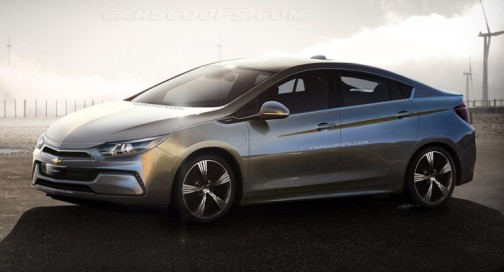 Some 69,000 of what marketing director Steve Majoros describes as “the happiest owners on earth” have already racked up 650 million electric miles on their Chevy Volts, and the 2011 model currently ranks tops in class on J.D. Power’s Dependability index. So we were expecting a steady-as-she-goes evolutionary redesign for the 2016 Volt. But what the development team calls the Gen II Volt will be far more radically redesigned than was the Gen II Prius. The entire drivetrain, power controller, battery, and virtually everything connecting the above has been redesigned, right down to the battery chemistry. The only carryover powertrain part is a little yellow shipping cap used to cover the attachment point for the shift linkage (and it gets thrown away at the factory). These new bits will get bolted into brand new bodywork too, but we won’t see that until January’s Detroit show.
Some 69,000 of what marketing director Steve Majoros describes as “the happiest owners on earth” have already racked up 650 million electric miles on their Chevy Volts, and the 2011 model currently ranks tops in class on J.D. Power’s Dependability index. So we were expecting a steady-as-she-goes evolutionary redesign for the 2016 Volt. But what the development team calls the Gen II Volt will be far more radically redesigned than was the Gen II Prius. The entire drivetrain, power controller, battery, and virtually everything connecting the above has been redesigned, right down to the battery chemistry. The only carryover powertrain part is a little yellow shipping cap used to cover the attachment point for the shift linkage (and it gets thrown away at the factory). These new bits will get bolted into brand new bodywork too, but we won’t see that until January’s Detroit show.
Further packaging improvements and mass reductions are being achieved by integrating the Traction Power Inverter Module and controller electronics onto the housing for the electric motors and transmission. This eliminates the big orange cables that used to connect the body-mounted controller to the transmission. This change, and the nature of ever-shrinking microelectronics, wrought a 60-percent volume reduction in the power electronics and helps the powertrain shed 100 pounds.
But the real kicker is the complete redesign of the guts of this transmission. Instead of having one big honker electric machine providing virtually all of the drive force through a single planetary gearset, there are now two separate motors of slightly different designs with different peak operating ranges. This allows them to work alone or together depending on the driver’s demands in different modes to better optimize efficiency. The smaller one uses a ferrite material in lieu of pricey and scarce rare-earth metals, and the other one uses a rare-earth formula that’s less rich in the rarest heavy metals (this model uses 60 percent less rare-earth metals). Two planetary gearsets now manage the five different operating modes (up from four, as reflected by the transmission’s official nomenclature: 5ET50, replacing 4ET50). There’s 10 percent less steel in the two motors for a 33-pound weight savings.
Low-speed acceleration is said to be improved by 20 percent, while overall drivetrain efficiency increases by 12 percent. So let’s make some wild guesses here. Let’s say the new Volt uses 70 percent of the battery pack that we’re guessing jumps to 20.5 kW-hrs (up from the current Volt’s 60 percent). That would suggest the current Volt’s EPA-estimated EV range of 38 miles might jump to 53. Factor in the 12-percent drivetrain-efficiency boost and you’re at 59 miles. One promise: Some of these assumptions are wrong, and factory claims will likely be conservative, but a 50-mile range will have a nice round marketing ring to it. Stay tuned for more info in January, and a complete explanation of the nitty-gritty planetary details when an SAE paper is published in February.